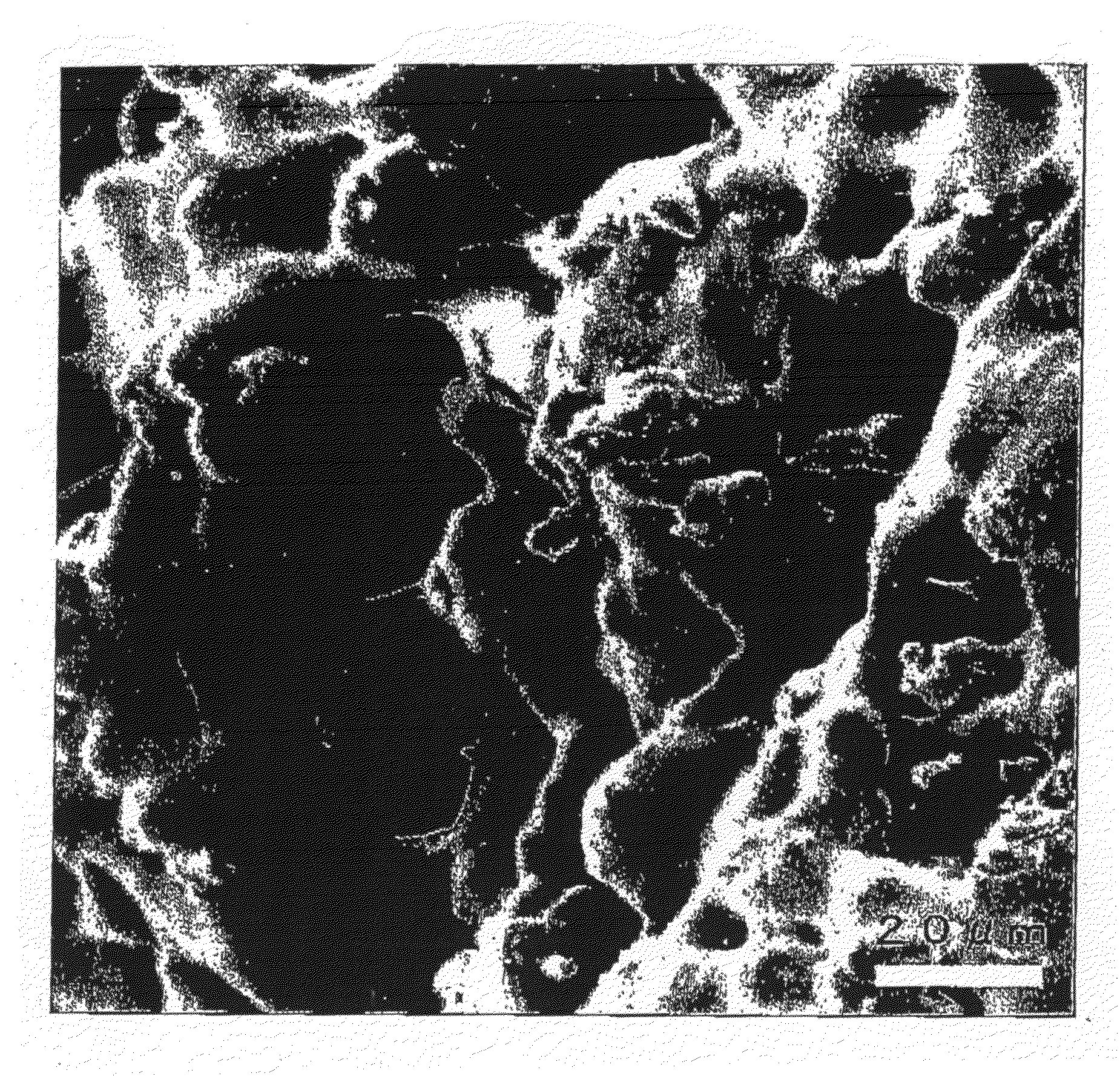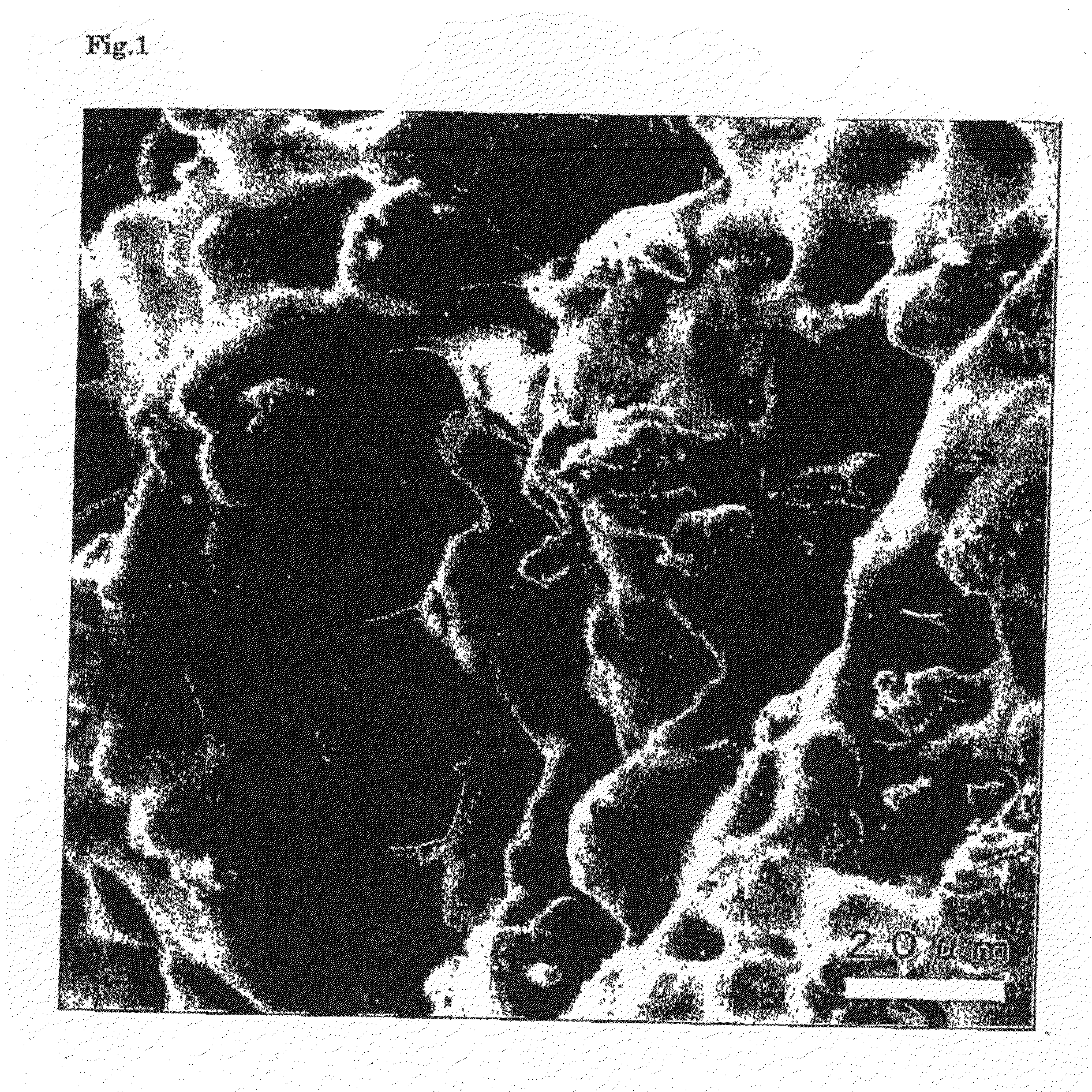Macroporous Carbon Material and Mesoporous Carbon Material Starting from Wood Material, Method for Producing them, and Porous Metal Carbon Material and Method for Producing it
a technology of mesoporous carbon and macroporous carbon, which is applied in the direction of crystal growth process, record information storage, catalyst activation/preparation, etc., can solve the problems of high environmental protection load in exhaust gas treatment, complicated and expensive production process of macroporous carbon material, etc., and achieves good isotropy and cheap production.
- Summary
- Abstract
- Description
- Claims
- Application Information
AI Technical Summary
Benefits of technology
Problems solved by technology
Method used
Image
Examples
example 1
Method of Controlling the Porousness of a Macroporous Carbon Material after Production, by Controlling the Atmospheric Pressure
[0038]From a cedar powder, particles having a particle size of about 30 μm (having a particle size distribution of from 25 to 32 μm) were sifted. The selected cedar powder was dried at 105° C. for 12 hours under atmospheric pressure. After drying, 5 mg of the cedar powder was filled into a stainless cylindrical mold container having a diameter of 5 mm and a height of 7 mm. Next, the container was set in a thermal decomposition unit (PY-2020D, by Frontia Lab.), then the temperature of the furnace for the thermal decomposition unit kept under a pressure of 300 kPa with helium gas kept introduced thereinto was stabilized at 800° C., and the mold container filled with the sample was dropped down and inserted into the furnace of the thermal decomposition unit, and kept heated for 1 hour. Next, the heating was stopped and this was naturally cooled to room temperat...
example 2
Method of Imparting Shapability to Macroporous Carbon Material Produced in Semi-Closed System
[0043]The results in Example 1 show that, according to the rapid heating method, a macroporous carbon material having a three-dimensional network structure was produced. However, the starting material jetted out from the exhaust vent of the sample container, and the shapability was poor. In this Example, tried was producing a macroporous carbon material excellent in shapability and having a three-dimensional network structure by rapid heating in a semi-closed system.
[0044]From a cedar powder, particles having a particle size of about 50 μm (having a particle size distribution of from 32 to 63 μm) were sifted. The selected cedar powder was dried at 105° C. for 12 hours under atmospheric pressure. After drying, 1 g of the cedar powder was filled into a graphite-made cylindrical mold (φ20: inner diameter 1 cm, outer diameter 2 cm, depth 5 cm) and a rectangular mold (thickness 1.1 cm, width 5.0 ...
example 3
Method of Imparting Shapability to Macroporous Carbon Material Obtained by the Use of Spacer
[0046]From a cedar powder, particles having a particle size of about 50 μm (having a particle size distribution of from 32 to 63 μm) were sifted. The selected cedar powder was dried at 105° C. for 12 hours under atmospheric pressure. Next, as in FIG. 3, a lower graphite-made spacer (outer diameter 3 cm, height 2.5 cm) was inserted into the bottom of a graphite-made cylindrical mold (φ44: inner diameter 3 cm, outer diameter 4.4 cm, depth 5 cm); and 0.2 g of the dried cedar powder was filled into it from the top. After being thus filled, an upper graphite-made spacer (outer diameter 3 cm, height 2.4 cm) was fitted into the top. The mold and the reactor were set in the chamber shown in FIG. 4, and the chamber was degassed to a reduced pressure of 40 Pa via a rotary pump. Next, this was stabilized under atmospheric pressure with nitrogen gas introduced thereinto. Next, the cylindrical mold was el...
PUM
| Property | Measurement | Unit |
|---|---|---|
| particle size distribution | aaaaa | aaaaa |
| porosity | aaaaa | aaaaa |
| density | aaaaa | aaaaa |
Abstract
Description
Claims
Application Information
 Login to View More
Login to View More - R&D
- Intellectual Property
- Life Sciences
- Materials
- Tech Scout
- Unparalleled Data Quality
- Higher Quality Content
- 60% Fewer Hallucinations
Browse by: Latest US Patents, China's latest patents, Technical Efficacy Thesaurus, Application Domain, Technology Topic, Popular Technical Reports.
© 2025 PatSnap. All rights reserved.Legal|Privacy policy|Modern Slavery Act Transparency Statement|Sitemap|About US| Contact US: help@patsnap.com



